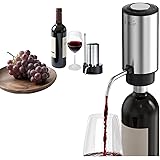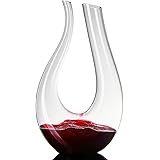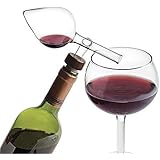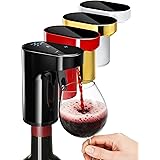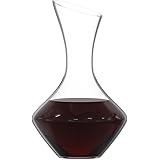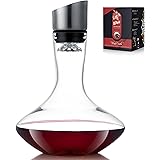Decoding the Glass: Every Wine Glass Explained for the Perfect Pour
Have you ever stood before a cabinet brimming with sparkling glassware, wondering which goblet is truly meant for your evening tipple? Or perhaps you’ve felt a slight pang of self-consciousness, grasping a wine glass by its bowl, only to recall a subtle nudge from an etiquette expert?
Indeed, the world of wine glasses can seem as intricate as the wines themselves. Yet, as the accompanying video brilliantly illustrates, each design is a symphony of purpose and pleasure, engineered to elevate your tasting experience. Let’s delve deeper into the fascinating nuances of these specialized vessels, exploring how the right glass can truly make your wine sing.
The Anatomy of a Wine Glass: More Than Meets the Eye
Before we explore specific types, it is essential to understand the fundamental components of a wine glass. Each element plays a crucial role in delivering the wine’s full potential. Conventionally, a wine glass comprises four main parts: the base, the stem, the bowl, and the lip.
The **base** provides stability, while the **stem** serves a vital function—it keeps your warm hand from influencing the wine’s delicate temperature. Holding the glass by the stem ensures the wine remains at its optimal serving temperature, preserving its intended profile. The **bowl**, undoubtedly the most expressive part, dictates how the wine interacts with air and how its aromas are presented. Lastly, the **lip**, or rim, significantly influences the wine’s flow onto your palate.
1. The Burgundy Glass: An Ode to Aromatic Reds
The Burgundy glass, often hailed as the MVP among its peers, is instantly recognizable by its generously wide, balloon-like bowl. This expansive design is far from mere aesthetics; it is a meticulously engineered chamber crafted for wines boasting a spectrum of complex aromas.
Consider the delicate yet powerful Pinot Noir, a quintessential Burgundy varietal. When swirled within this grand vessel, its intricate scents are artfully trapped, converging at the narrower opening to create an intoxicating bouquet. Furthermore, the glass’s notably thin lip ensures a smooth, uninhibited delivery of wine, allowing it to glide gracefully onto the tongue. For high-acid wines like Pinot Noir, the specific curvature directs the liquid to the sides of the tongue, accentuating those crisp, vibrant notes that dance across the palate.
While ideally suited for its namesake and other light-bodied, aromatic red wines, the Burgundy glass demonstrates surprising versatility. It can beautifully enhance various other red wine experiences, even accommodating more unconventional beverages like a festive margarita, should the spirit move you.
2. The Bordeaux Glass: For the Bold and Structured
In contrast to its Burgundy counterpart, the Bordeaux glass is built for wines of significant structure and robust character, such as the powerful Cabernet Sauvignon or Merlot. This glass commands attention with its substantial stature and a bowl that, while still large, is notably narrower and taller than the Burgundy glass.
This design decision is deliberate. Wines from Bordeaux and similar regions are often rich in tannins, which can initially present as astringent. The Bordeaux glass acts as a personal trainer for these wines, providing ample room for aeration without allowing the aromas to dissipate too quickly. This controlled breathing allows the wine to “stretch its legs,” softening the tannins and allowing layers of fruit and spice to unfold naturally.
Unlike the Burgundy glass, the Bordeaux often features a more straight-sided bowl near the lip, encouraging oxygen to interact continuously with the wine as it is consumed. Consequently, the wine flows smoothly across the palate, hitting all the right spots and allowing its bold flavors to spread evenly, culminating in a balanced and elegant experience.
3. The Chardonnay Glass: A Study in Subtlety (and Contradiction)
The traditional Chardonnay glass is often perceived as a minimalist design: shorter, with a more compact bowl than its red wine brethren. This scaled-down size is intentional, devised to suit white wines that are naturally aromatic and acidic, and thus require less exposure to air to express their character.
However, this glass presents an interesting paradox. While designed for specific white varietals, a truly nuanced Chardonnay—especially one that is oaked and full-bodied—can sometimes feel constrained by its smaller volume. When the wine hits the palate all at once, rather than spreading gracefully, the experience can feel somewhat truncated or “in a rush,” as the video describes.
Indeed, many sommeliers suggest a larger glass, even a Bordeaux glass, for complex Chardonnays, enabling them to unfurl their rich textures and layered aromas. For lighter, unoaked white wines, the traditional Chardonnay glass performs admirably, maintaining their crispness without over-oxidization. Therefore, while compact, its suitability hinges on the specific style of white wine being served.
4. The Port Glass: Sweetness in a Small Package
When the occasion calls for a fortified wine like Port, Sherry, or a rich dessert wine, the Port glass takes center stage. This smaller, often elegantly flared glass is a celebration of concentration and sweetness, perfectly proportioned for wines that deliver a greater alcoholic punch and intense flavor profiles.
The narrower bowl of the Port glass masterfully concentrates those sweet, aromatic notes, especially crucial for varietals like White Port or a fragrant Eiswein. Moreover, the diminutive size accommodates the typical 3-ounce pour for dessert wines, preventing a smaller serving from appearing sparse or unfinished in a larger glass. This contrasts sharply with the standard 5-ounce pour for table wines.
Conspicuously, the smaller glass also alters the wine’s trajectory onto the palate, directing it more centrally where sweetness receptors are most pronounced. Ultimately, introducing Port glasses to the table is more than a practical choice; it is an immediate signal for celebration, signaling that a delightful, sweet conclusion to a meal is at hand.
5. The Champagne Flute: A Bubbling Spectacle
The Champagne flute is synonymous with celebration, a vessel seemingly tailor-made for sparkling wines. Its iconic tall, narrow design, typically around 2 inches wide at the base, is ingeniously functional: it minimizes the surface area exposed to air, thereby slowing the escape of effervescence.
Consequently, the bubbles in your Prosecco or Cava remain vibrant and persistent, ensuring that signature sparkling experience with every sip. Yet, this very design presents a charming dilemma. While perfect for preserving effervescence and adding a touch of festive pizzazz—much like adding “sprinkle filters” to an Instagram story for your drink—its narrow opening makes it nearly impossible to swirl and properly evaluate the wine’s complex aromas, which Champagne itself certainly possesses.
Thus, for casual toasts and lighter sparkling wines like Moscato d’Asti, the flute reigns supreme. However, for a truly profound Champagne, some connoisseurs advocate for wider-mouthed glasses that allow its nuanced bouquet to develop more fully, a testament to Champagne’s status as a serious wine beyond its bubbles.
6. The Coupe Glass: A Touch of Vintage Glamour
Stepping back in time, the Coupe glass offers a dramatically different approach to sparkling wine enjoyment. Legend, perhaps apocryphal, suggests its wide, shallow bowl was modeled after Marie Antoinette’s breast, lending it a certain historical mystique and undeniable personality. It is, in essence, the antithesis of the Champagne flute.
The Coupe’s expansive surface area allows bubbles to dissipate rapidly, making it less ideal for maintaining effervescence. Swirling wine in this glass is impractical, as it is simply not engineered for such traditional wine tasting rituals. Nevertheless, its wide bowl is excellent at capturing broader aromas, making it a compelling choice for aromatic cocktails.
Indeed, the Coupe glass embodies a relaxed, convivial spirit. It shines brightest when serving sparkling cider, casual bubbly, or a range of classic cocktails, perfectly complementing a vintage aesthetic and a festive, unpretentious atmosphere.
7. The Stemless Glass: Casual Elegance Reimagined
Emerging into popularity in the late 1990s and early 2000s, the stemless wine glass represents a significant shift towards a more relaxed and practical approach to wine consumption. By omitting the stem and base, this design embodies convenience without sacrificing the core functionality of a good wine vessel.
These glasses are inherently more robust and less prone to breakage, making them an ideal choice for outdoor gatherings, picnics, or simply enjoying a glass of wine on the couch without undue fuss. Crucially, the absence of a stem does not impede the ability to swirl wine, allowing for aeration and aroma release just as effectively as a stemmed glass.
The stemless glass champions a laid-back wine experience, combining durability with a sleek, modern aesthetic that effortlessly blends into diverse casual settings. It democratizes the wine ritual, making it accessible and enjoyable for every occasion.
8. The Universal Glass: The One-Size-Fits-Most Solution
For those who prefer simplicity without compromising quality, the Universal wine glass stands as an elegant solution. While technically often designed with white wine characteristics in mind, its sophisticated, balanced shape makes it remarkably versatile, adept at enhancing almost any wine it holds.
This glass typically features a sleek, airy profile with a subtle taper, expertly designed to capture and concentrate a wide range of aromatic compounds. The super thin lip ensures a refined sip, allowing the wine to flow smoothly and express its inherent qualities irrespective of varietal.
While premium versions can be on the pricier side, reflecting their delicate craftsmanship and superior performance, more accessible options exist. Ultimately, if faced with the challenge of selecting just one type of wine glass for all your bottles, the Universal glass presents a compelling argument for its balanced design and unwavering adaptability. It’s a testament to the idea that sometimes, less truly is more, especially when it comes to enjoying the diverse world of wine.


